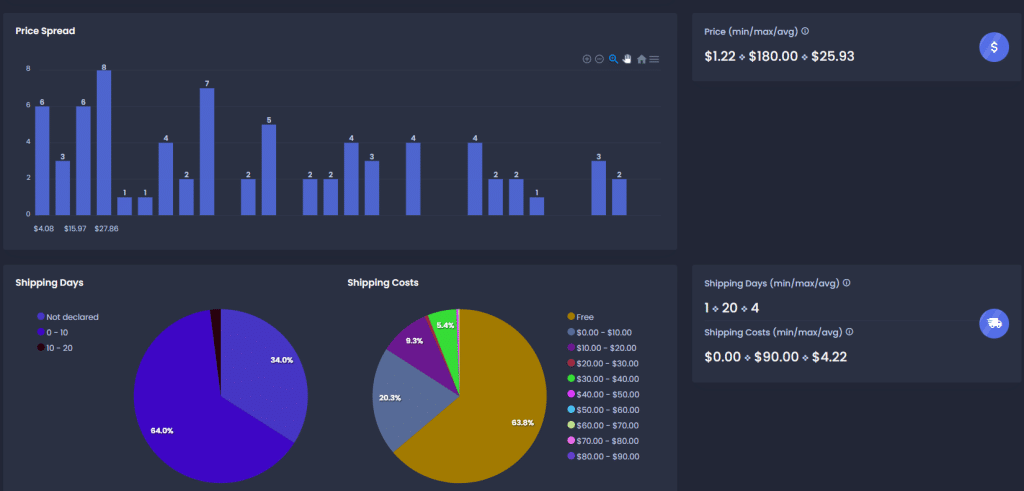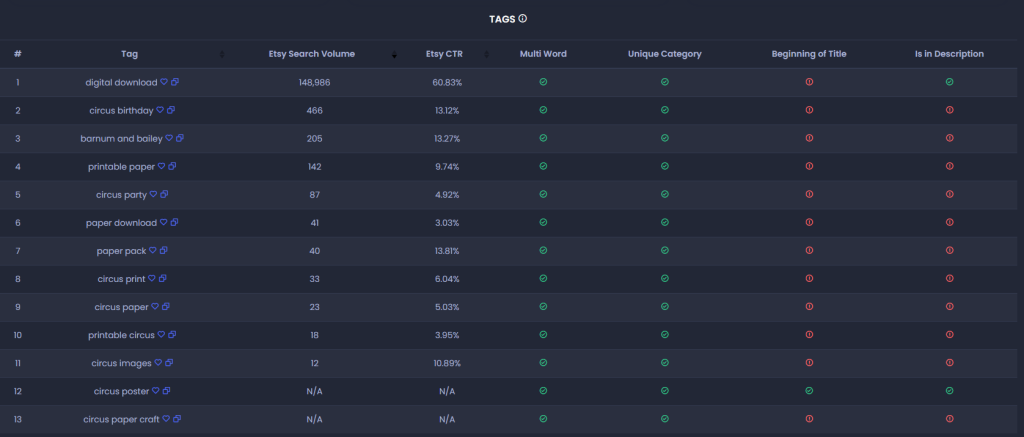
If you’re a crafter with a hobby, Etsy is the place to be.
The platform offers artists the opportunity to showcase their unique handmade gems and connect with a global audience.
In the following sections, we’ll walk you through the process of transforming your passion into a lucrative Etsy gig.
From finding your niche to optimizing your listings, we’ll cover all that will help you land more sales from your hobby crafts.
How to turn your hobby into a money-making machine on Etsy
The beauty of Etsy is that it’s full of diversity.

In that sense, a range of hobby-related niches are making waves and triggering excitement among shoppers. Some of the most popular ones we identified include fishing, dancing, hiking, knitting, pottery, and gardening.
Although this screams opportunity, it also means highly competitive markets.
Why? Because the more well-developed a segment is, the higher the listing saturation.
Naturally, this calls for a bulletproof strategic approach, which will help you stand out from the crowd.
The tips below will help you achieve this.
Finding your niche
Before thinking about tactics to attract shoppers, ask yourself one key question – what hobby niche will you be selling in?
In short, your niche is the specific market segment in which you’ll be positioning your listings (for example, wine tasting).
But there’s more to it.
Let’s say that your hobby is photography. While photography does classify as a niche, going even deeper will help you gain a competitive advantage over other sellers. It will enable you to target specific audiences and satisfy a particular demand.
In the case of photography, niching down could include selling items strictly related to wedding photography or outdoor photography.

Remember that it’s essential to choose a theme that aligns with your passion and skills.
Here are a few tips on how to do this.
Self-reflection
Consider what you’re enthusiastic about and what type of activities you enjoy. Your passion will shine through in your products, attracting like-minded customers.
Best of all, being experienced in a hobby will enable you to connect to your audience with valuable, on-point creations.
For example, if you love knitting, your niche could be handmade knitwear, specializing in cozy winter scarves. If you follow the craze in the space, you’re likely to appeal to Etsy shoppers with trending designs, colors, and materials.
Market Research
But the way you feel about a hobby won’t be enough to guarantee sales. It’s also critical to look at data.
Use Sale Samurai to explore the market and investigate the competition within your chosen domain.
Here are the basics you should cover:
- Determine the size of the niche. Some of the key metrics to consider are the competition level of related keywords and the number of listings in the space.
- Identify the demand for products in your chosen niche. You can do this by looking at the search volumes of keywords and phrases.
- Look at successful Etsy shops that offer similar products. Identify gaps or opportunities for improvement in the market.
- Explore the average prices in the space and make brief calculations to forecast how profitable you are likely to be.

Imagine that while there are many knitwear shops, very few offer custom-designed scarves with intricate patterns. You’ve also noticed that there is a high demand for these products, which are also not very cheap.
You could use this opportunity to focus your efforts on filling this gap and skyrocketing your sales.
Uniqueness
No matter the niche you’ve selected, make sure to differentiate yourself by offering something unique to your audience. This could be a distinct style, customization options, or exceptional craftsmanship.
After all, Etsy users are predominantly inspired by authentic and extraordinary offers.
Using the knitting example from above, you could create one-of-a-kind scarves with intricate fair isle patterns, allowing customers to choose their colors and models.
Setting Up Your Etsy Shop
Once you’ve defined your niche, it’s time to set up your Etsy shop.
A well-organized and visually appealing shop can attract potential customers. To be able to do this, you’ll need to think about presentation, portfolio, and diversification.
Shop name and branding
While in most cases your listings are what attracts traffic, your shop name can also play a significant role.
Present your shop in a way that reflects your niche. Apart from a strategic name. create a logo and banner further help bring your brand to life..
For instance, if your niche is handmade candles, your shop name could be “Glowing Ambiance” with a logo featuring a candle flame.
This approach will help you build trust through creativity and consistency.
Product portfolio
Next, think about your product portfolio.
An adequate product portfolio can help you reach a broader audience, boost sales, and establish your brand’s identity.
To do so, identify current market trends for your hobby. Understand what types of products are in high demand and what styles, colors, or themes are popular.
By understanding your target audience’s preferences, needs, and buying behavior you can tailor your product portfolio to meet expectations.
It’s also recommended to keep your items organized. Divide your hobby-based products into categories or collections according to their characteristics, themes, or intended use.
This helps customers navigate your shop more easily.
For example, if you sell handmade jewelry, you might categorize products by materials (silver, gemstone), style (boho, minimalist), or occasions (weddings, everyday wear).
Product diversification
After you’ve established the foundations of your portfolio, think about diversification.
Consider adding complementary products within your niche to cater to a broader audience.
Say you’ve identified that selling scented candles is a successful market that fits well with your hobby – yoga. You could expand your product line to include wax melts and candle accessories.
This will enable you to attract diverse buyer groups to your shop and ultimately increase sales.
Listing optimization
The next stage of your journey is equipping your shop for success via listing optimization.
Keywords and tags
The first thing that you need to think about is using keywords and tags strategically. This will help you become visible to your audience.
Keywords should be utilized throughout your shop description, listing titles, and listing descriptions. They will be analyzed by Etsy’s algorithm, which will determine how relevant your products are to your target shoppers.

Ideally, aim to use words that have high search volumes and low competition. These are the choices that are easiest to rank for and therefore quickest to show results.
In addition to keywords, every listing can contain up to 13 tags. The role of these tags is similar to that of keywords. The only difference is that they live in the back end and won’t take up any description or title space.
Ideally, strive to use all tag slots available to maximize your discoverability.
Imagery
Now, let’s say that you’ve nailed your keywords and you now rank high in the first pages of search results.
One detail will shape your performance from this moment onwards – imagery.
The visual representation of your products is what ultimately intrigues customers to learn more about your handmade hobby item. Considering that your listing shares a page with many similar products, your images must stand out.
Etsy grants 10 image slots to every listing. Use them to the fullest and make sure you’re showcasing your products according to the audience, the theme, and the niche.
Pricing strategy
Pricing is another fundamental component of listing optimization.
Let’s assume you’ve produced a stunning hobby-related item, optimized your listing, and are currently enjoying a lot of traffic. Your price is what will make or break the purchase.
Research similar products and price your items competitively. Consider your production costs, time, and desired profit margins.
Let’s say you find that similar listings are priced between $10 and $20. After factoring in your costs and desired profit, you set your products at $15 each. This will help you remain profitable and competitive at the same time.
Marketing and promotion
Creating an Etsy shop with a diverse product portfolio in a hobby-related niche is just the beginning.
You’ll need to actively market your handmade gems to drive traffic and sales.
Encourage customers to leave reviews about their experience with your products. Positive feedback builds trust and credibility but also influences your rankings.
Promoting your products on external platforms like social media channels, personal blogs, or email marketing is also essential.
This will help you popularize your name as a seller and encourage more followers from your community to visit your Etsy shop. Ultimately, this increases your chances of landing more sales.
Conclusion
Transforming your hobby into a top-selling Etsy gig is a rewarding journey that requires dedication, creativity, and business acumen.
By following the tips and tricks from above, you can turn your passion into a profitable venture.
Remember that success on Etsy takes time, patience, and a commitment to delivering high-quality products and exceptional customer service. With the right approach and data-backed decisions, you can become a profitable Etsy seller while doing what you love.





